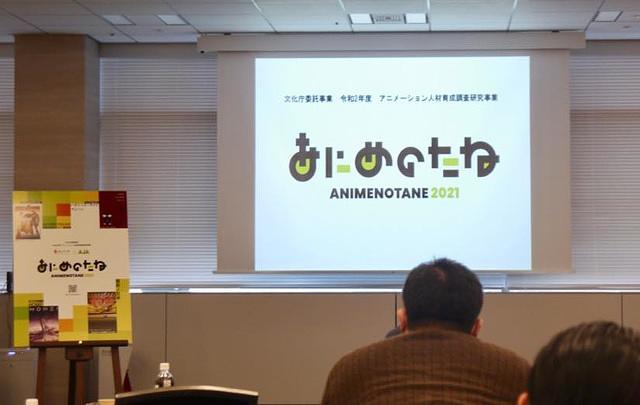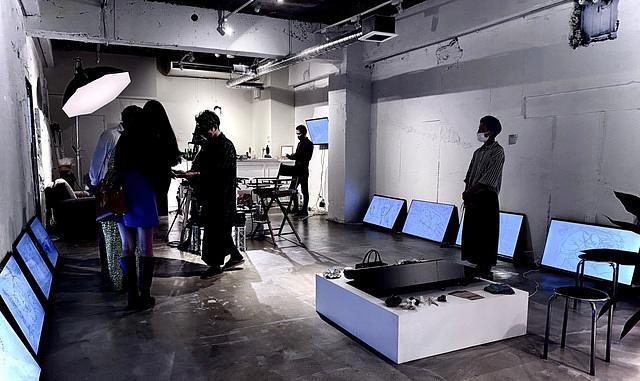“Anime no Tane 2021” What are the challenges of animation production and human resource development in the Corona pandemic? Project Report Symposium [Report]

A symposium was held to report on the activities of "Anime no Tane 2021", a project that aims to develop human resources who will be responsible for the future of Japanese animation culture.
"Anime no Tane" is the nickname of the project commissioned by the Agency for Cultural Affairs, the Japan Animations Association.
The purpose of this project is to contribute to the improvement and development of the animation field in Japan by conducting practical surveys and research on how to develop animation human resources, and by promoting the evaluation and dissemination of the results of the surveys and research.
From this year, they aim to pass on the skills necessary for total animation production through the production of works, not only for animators but also for production progress, CG artists, editors, and sound artists.
This project consists of three main programs: the first is the "Program for Succession of Skills through Production," which aims to provide practical training through on-the-job training through the production of works that demonstrate the individuality of the four companies commissioned to produce the works; the second is a technical improvement education program for those working in the animation industry; and the third The second is a technical improvement education program for those working in the animation industry, and the third is a basic education program for applicants to the animation industry.
In this symposium, the results of each program were presented in detail.
In the report on the results of the Technology Transfer Program, short animations produced by the four participating groups were screened, and each group gave a presentation on how they had implemented and educated themselves.
IMAGICA Lab., which produced "DELIVER POLICE", set the goal of learning the five items that are considered important in animation production.
They learned the following five things through practice and classroom lectures: "learning human movement from actors", "accurately grasping the intentions of the storyboard and being able to add acting and expression", "having a perspective on work processes other than their own", "working while understanding the meaning of directing instructions", "drawing director's correction instructions, etc., and acquiring digital knowledge through cooperation with digital video".
They interviewed the martial arts organization Krav Maga Japan and recorded a demonstration of the action. They observed in detail how the body moves and the center of gravity shifts, and drew the images.
They also took on the challenge of digital original drawing and video work to improve the efficiency of drawing and material transportation. They aimed to ensure the quality of his work by using vector data that does not produce rough lines even when enlarged.
The next presenter, Usagi-Oh Corporation, the creator of "Honey Suicide Machine," said that their goal was to present a new way of making animation.
The three themes for this project were "Succession", "Innovation", and "Transparency".
The young and senior animators worked in pairs, and the close communication made it possible for them to pass on their skills smoothly. On the other hand, there was an aspect that they felt was not easy to train remotely with people who were meeting each other for the first time.
For the second theme, "Innovation," they used the free 3D tool Blender. The project was created with the aim of optimizing production and cost for a small number of people.
Although they struggled with some aspects of Blender's unique specifications, they felt that the advantages outweighed the disadvantages, such as the low cost due to its free nature, the wide variety of add-ons, and the ease of comparing multiple takes.
As for the third point, "transparency," they said that they plan to disclose all documents and data related to this production, and they hope that the training will be used as a reference to pass on the techniques.
The third organization, Orange Co., Ltd. produced "HOME!
This project focused on the training of animators and modelers, and they incorporated motion capture and tackled issues such as how to convert the movements of real people into CG animation.
Many of the staff members were new to the challenge of character acting, so they were instructed on the process of how to add movement and how to make it look like animation, and even those who were new to the challenge were able to give shape to their work in a short period of time.
For the training of the modelers, they used Blender, which has various advantages such as light processing, the ability to redo after setup, and non-destructive operations.
One male character and one female character appear in this work. The male character is realistically sculpted, while the female character is designed in an anime style, and the challenge was to create different types of modeling. The female character with the anime design was by far the most difficult to model, requiring a lot of adjustments to make it work even with an aori or vertical composition.
The last presentation was by Tsumugi Akita Anime Lab, which produced "Ryusatsu no Kyokotsu".
The goal was to create a new style of animation while maintaining the best parts of traditional animation.
What was unique about the company's attempt was that they drew the whole body acting without being bound by cut frames. They drew the whole body and decided the frame later. This helped them understand the shifting of the center of gravity of the whole body, which led to the improvement of their technical skills.
Also, by deciding on the frame after drawing the whole body, it is possible to bring to the animation scene the feeling of watching the actor's performance and deciding on the frame on the spot, just like on the set of a live-action film.
They also had the animators themselves operate the 3DCG backgrounds to deepen their understanding of the layout and camera angles. These attempts were based on the idea of training staff to be aware of the final screen creation.
Some of the staff members were not good at drawing with an awareness of things like feet outside the frame, and they felt that this method promoted their understanding of such movements and improved their technical skills.
In the latter half of the symposium, there was a presentation of the results of the technical improvement education program for those working in the animation industry and the basic education program for those applying to the industry.
Until the year before last, this program was only for young animators. This year, however, the program was expanded to include all workers in the animation industry, and any occupation can participate.
In order to prevent the spread of the coronavirus, this year's course was conducted online via video distribution. This has resulted in a significant increase in the number of participants, with a total of nearly 2,000 people viewing the videos.
The course was generally well-received for its easy-to-understand content and the fact that it was possible to participate even from rural areas, but there were some complaints from participants about the lack of practical guidance.
In addition, the basic education program for industry aspirants also adopted an online format and conducted a hybrid workshop with face-to-face sessions in collaboration with local educational institutions to explore new ways of workshops during the corona pandemic.
Finally, Kawaguchi Yoshitaka, the chairman of the "Anime no Tane 2021" development committee, summarized the project. He praised the fact that each of the four groups that worked on the project had an awareness of the issues that would affect animation production in the future.
Each of the four groups is taking a different approach to digitalization, and we can expect to see a variety of animation production methods in the future.
He concluded the symposium with his outlook that it would be necessary to create an environment where both newcomers and veterans could learn in a flat manner.
"Anime no Tane" is the nickname of the project commissioned by the Agency for Cultural Affairs, the Japan Animations Association.
The purpose of this project is to contribute to the improvement and development of the animation field in Japan by conducting practical surveys and research on how to develop animation human resources, and by promoting the evaluation and dissemination of the results of the surveys and research.
From this year, they aim to pass on the skills necessary for total animation production through the production of works, not only for animators but also for production progress, CG artists, editors, and sound artists.
This project consists of three main programs: the first is the "Program for Succession of Skills through Production," which aims to provide practical training through on-the-job training through the production of works that demonstrate the individuality of the four companies commissioned to produce the works; the second is a technical improvement education program for those working in the animation industry; and the third The second is a technical improvement education program for those working in the animation industry, and the third is a basic education program for applicants to the animation industry.
In this symposium, the results of each program were presented in detail.
In the report on the results of the Technology Transfer Program, short animations produced by the four participating groups were screened, and each group gave a presentation on how they had implemented and educated themselves.
IMAGICA Lab., which produced "DELIVER POLICE", set the goal of learning the five items that are considered important in animation production.
They learned the following five things through practice and classroom lectures: "learning human movement from actors", "accurately grasping the intentions of the storyboard and being able to add acting and expression", "having a perspective on work processes other than their own", "working while understanding the meaning of directing instructions", "drawing director's correction instructions, etc., and acquiring digital knowledge through cooperation with digital video".
They interviewed the martial arts organization Krav Maga Japan and recorded a demonstration of the action. They observed in detail how the body moves and the center of gravity shifts, and drew the images.
They also took on the challenge of digital original drawing and video work to improve the efficiency of drawing and material transportation. They aimed to ensure the quality of his work by using vector data that does not produce rough lines even when enlarged.
The next presenter, Usagi-Oh Corporation, the creator of "Honey Suicide Machine," said that their goal was to present a new way of making animation.
The three themes for this project were "Succession", "Innovation", and "Transparency".
The young and senior animators worked in pairs, and the close communication made it possible for them to pass on their skills smoothly. On the other hand, there was an aspect that they felt was not easy to train remotely with people who were meeting each other for the first time.
For the second theme, "Innovation," they used the free 3D tool Blender. The project was created with the aim of optimizing production and cost for a small number of people.
Although they struggled with some aspects of Blender's unique specifications, they felt that the advantages outweighed the disadvantages, such as the low cost due to its free nature, the wide variety of add-ons, and the ease of comparing multiple takes.
As for the third point, "transparency," they said that they plan to disclose all documents and data related to this production, and they hope that the training will be used as a reference to pass on the techniques.
The third organization, Orange Co., Ltd. produced "HOME!
This project focused on the training of animators and modelers, and they incorporated motion capture and tackled issues such as how to convert the movements of real people into CG animation.
Many of the staff members were new to the challenge of character acting, so they were instructed on the process of how to add movement and how to make it look like animation, and even those who were new to the challenge were able to give shape to their work in a short period of time.
For the training of the modelers, they used Blender, which has various advantages such as light processing, the ability to redo after setup, and non-destructive operations.
One male character and one female character appear in this work. The male character is realistically sculpted, while the female character is designed in an anime style, and the challenge was to create different types of modeling. The female character with the anime design was by far the most difficult to model, requiring a lot of adjustments to make it work even with an aori or vertical composition.
The last presentation was by Tsumugi Akita Anime Lab, which produced "Ryusatsu no Kyokotsu".
The goal was to create a new style of animation while maintaining the best parts of traditional animation.
What was unique about the company's attempt was that they drew the whole body acting without being bound by cut frames. They drew the whole body and decided the frame later. This helped them understand the shifting of the center of gravity of the whole body, which led to the improvement of their technical skills.
Also, by deciding on the frame after drawing the whole body, it is possible to bring to the animation scene the feeling of watching the actor's performance and deciding on the frame on the spot, just like on the set of a live-action film.
They also had the animators themselves operate the 3DCG backgrounds to deepen their understanding of the layout and camera angles. These attempts were based on the idea of training staff to be aware of the final screen creation.
Some of the staff members were not good at drawing with an awareness of things like feet outside the frame, and they felt that this method promoted their understanding of such movements and improved their technical skills.
In the latter half of the symposium, there was a presentation of the results of the technical improvement education program for those working in the animation industry and the basic education program for those applying to the industry.
Until the year before last, this program was only for young animators. This year, however, the program was expanded to include all workers in the animation industry, and any occupation can participate.
In order to prevent the spread of the coronavirus, this year's course was conducted online via video distribution. This has resulted in a significant increase in the number of participants, with a total of nearly 2,000 people viewing the videos.
The course was generally well-received for its easy-to-understand content and the fact that it was possible to participate even from rural areas, but there were some complaints from participants about the lack of practical guidance.
In addition, the basic education program for industry aspirants also adopted an online format and conducted a hybrid workshop with face-to-face sessions in collaboration with local educational institutions to explore new ways of workshops during the corona pandemic.
Finally, Kawaguchi Yoshitaka, the chairman of the "Anime no Tane 2021" development committee, summarized the project. He praised the fact that each of the four groups that worked on the project had an awareness of the issues that would affect animation production in the future.
Each of the four groups is taking a different approach to digitalization, and we can expect to see a variety of animation production methods in the future.
He concluded the symposium with his outlook that it would be necessary to create an environment where both newcomers and veterans could learn in a flat manner.




